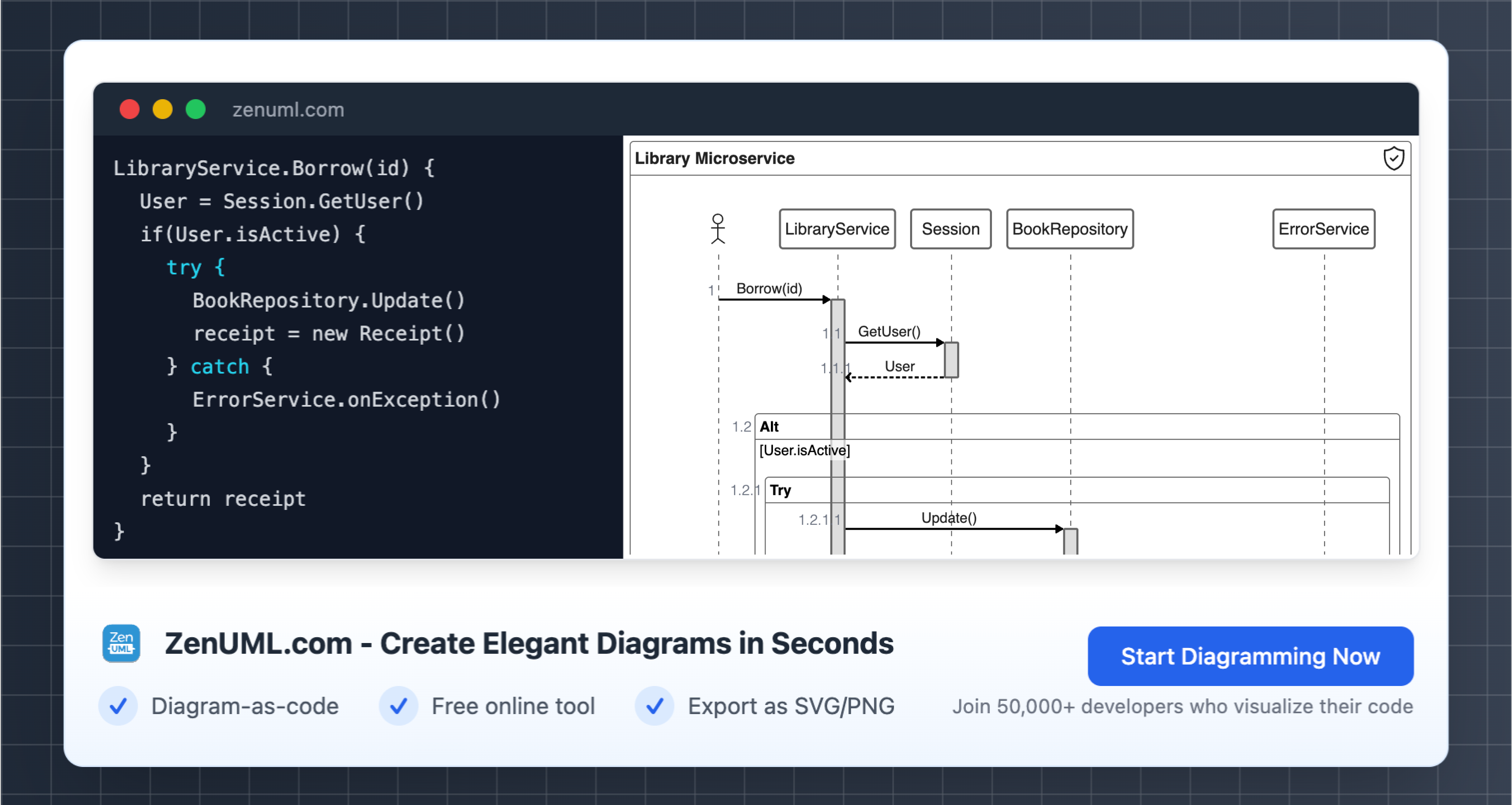Introduction
Sequence diagrams, a part of the Unified Modeling Language (UML), are integral in visually representing complex processes and system interactions. Yet, for many developers and stakeholders, deciphering cluttered and convoluted diagrams can be a challenging task. That’s where the concept of diagram simplification and clarity comes into play.
The design of sequence diagrams is just as crucial as the information they carry. A simplified, clear diagram can break down the most intricate processes, making information accessible and understandable. This blog post focuses on how to push the boundaries of productivity and comprehension using sequence diagrams—delivering clarity without sacrificing details.
With statistics showing that visual aids improve comprehension by 400%, there is no better time to revisit how we construct sequence diagrams. In this guided exploration, we’ll uncover methods to simplify diagrams and visualize a new proof-of-concept for building clarity.
Why Simplification Matters in Sequence Diagrams
Complexity is the enemy of communication. Sequence diagrams are often used by developers, analysts, and designers to illustrate interactions between system components. But as systems evolve, diagrams can quickly spiral into chaos with sprawling layers of arrows and boxes.
Simplification matters because:
- 60% of developers find it difficult to collaborate when diagrams are overly complicated.
- Clear diagrams reduce misunderstandings, especially in cross-functional teams.
- Ambiguity in software design wastes 40% of a project’s time rescoping or debugging later stages.
Consider the example below of a sequence diagram that’s cluttered and challenging to follow:
Even with simple interactions, multiple notes, and repeated sequences can make diagrams challenging to read.
Section 1: The Core Components of a Clear Sequence Diagram
Before we dive into improving clarity, it’s critical to understand the core building blocks of sequence diagrams. Here’s a breakdown:
1. Participants
Participants are represented as boxes or objects along the top of the diagram. For example: User, System, or Database. They signify the actors involved in the process.
2. Messages
Arrows between participants denote messages. These can be synchronous or asynchronous actions, which highlight the type of interaction.
3. Lifelines
Lifelines are vertical dotted lines that track the lifetime of a participant within the interaction sequence.
4. Activation Bars
These bars illustrate the execution time of a participant during a process.
Understanding these core elements enables you to construct diagrams purposefully, ensuring legibility rather than overloading your audience with unnecessary elements early on.
Key Simplification Tips:
- Use short, meaningful labels for participants and messages.
- Limit the number of participants to 5-7 for better clarity.
- Clearly differentiate synchronous and asynchronous messages.
Let’s see a refined version of the earlier example:
Notice the reduced clutter and clean organization. Simplified interactions make it easier for reviewers to follow.
Section 2: Techniques to Simplify Sequence Diagrams
Simplifying does not equate to removing essential details. Instead, focus on restructuring the diagram. Here’s how:
1. Group Repeating Processes
When repetitive sequences occur, group actions into overarching descriptions rather than repeating each interaction.
For example:
Using the loop notation reduces redundancy and conveys logic concisely.
2. Highlight Key Interactions
Use notes and simplified annotations sparingly to guide users through the diagram. Avoid overexplaining with multiple notes.
Example of targeted use:
3. Focus on Relevant Participants
Eliminate actors or arrows that are peripheral to understanding critical interactions. Keep your diagram focused on the intent.
4. Apply Swimlanes for Role Distinction
Especially in diagrams with multiple departments or systems, adding visual swimlanes helps differentiate roles.
When working with cross-functional teams, swimlanes ensure clarity regarding ownership of steps.
Section 3: Emerging Trends in Sequence Diagram Design
As development tools and modeling approaches continue evolving, we are pushing the boundaries of how interactive diagrams aid collaboration. Emerging trends include:
1. Interactive Diagrams
Tools like ZenUML are being enhanced with interactive features, allowing viewers to click through different processes dynamically rather than static visuals.
2. Automated Revision Suggestions
Intelligent software can now recommend simplifications, flagging overlapping sequences or unnecessary complexity.
3. Real-Time Diagram Updates
With DevOps practices on the rise, diagrams are increasingly integrated into CI/CD pipelines, updating dynamically as the system evolves.
4. Integration with Project Management Tools
Sequence diagrams are no longer isolated assets. They are being linked with issue tracking in tools like Jira or Trello, where team collaboration processes directly correspond to system behavior.
By adopting these practices, sequence diagrams transform into living, evolving tools that adapt and clarify.
Section 4: Proof of Concept—Reimagining Simplified Sequence Diagrams
Let’s set a proof-of-concept by modeling a simplified process with real-world relevance: A basic e-commerce checkout flow.
Here’s the traditional approach:
The above is functional, but with complex systems, processes tend to become more crowded. A reimagined simplified design would focus primarily on key steps, leveraging grouping mechanisms for better clarity:
By focusing the session explicitly on the flow’s purpose and grouping repetitive interactions, we enhance readability while retaining critical meaning.
Conclusion
Simplifying and enhancing the clarity of sequence diagrams is a critical step toward effective communication in system design. With techniques like grouping, highlighting, and interactive diagrams, we’ve touched on how to push the boundaries of this visual tool. Statistically, teams that employ better diagrams reduce misunderstandings by 32%, fostering collaborative success.
Now that we’ve unlocked these strategies, it’s your turn! What’s your biggest challenge in working with sequence diagrams? Share your thoughts and questions in the comments below, and let’s continue this conversation.
Try ZenUML now!
Zenuml detailed feature roadmap available here.

